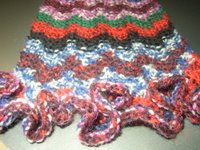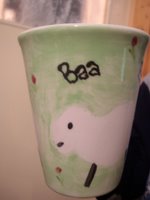Museum meanderings!
Whilst wandering round the museum (mentioned in my last post), I came upon the section on knitting and its history.
Knitting is a young craft, compared to spinning and weaving, but fixing a date for its origin is complicated by the perishability of natural fibers. Historic evidence of knitted pieces have been found in several countries such as Egypt, England, Holland, Scotland, Spain, Germany and many others.
The earliest evidence (so far) of knitted clothing found were fragments of socks that were made in Egypt sometime between 1000 and 1300 A.D. But, even this is disputed since some scholars say that these socks were not knitted but were the result of naalebinding.
The word "knitting" comes from the Sanskrit word "Nahyat" which translates as "net" or "weave". It is thought that knitting may have been transmitted from the Middle East to Europe through Spain, by the Moors. Throughout the Middle Ages, knitted hose and stockings, of both silk and wool replaced bias-cut hose among the upper class. Samples from the period show knit and purl patterning, as well as eyelet patterning.
Stocking knitting grew rapidly during the reign of Queen Elizabeth I and was seen as a suitable occupation for the poor to provide income. Schools of knitting were established, with varying degrees of success. Knitting spread throughout the countryside and to the Scottish Islands as a source of supplemental income. Hand knitting was a means of earning a living for many people in Scotland at least as early as the 15th Century and remained important in many areas, particularly Shetland where it continues to be important many 100's of years later.

Here you see a set of 4 metal number 17 needles, a knitting sheath of quills and a leather knitting belt all from Shetland. The knitter would stick one of the needles into the sheath or in the holes in the belt to hold it firm
Makkin (knitting) belts are worn around the waist, with the leather pouch to the right hand side of the knitter's body. They are used by sticking the end of the right hand knitting needle into the pouch, which is filled with horsehair. This frees up the knitter's right hand to manipulate the yarn, making the process much quicker. The belt also supports some of the weight of the garment being knitted.
These brightly coloured knitting sheaths were once used by knitters to help them to knit faster. The narrow end of the knitting sheath was tucked into the right side of the knitter's skirt or apron, and the knitting needle was inserted into the open end among the quills. This freed up the knitter's right hand, and enabled them to knit much faster. These were once made from a bundle of straw simply bound with twine and were called 'wisps', wisp being the word for loose straw.
An early sign of the knitting trade appears in 1496 when the "Bonnetmakers of Dundee" formed a trade in corporation. For many years they produced a cheap imitation of the black velvet bonnets worn by the wealthy. This knitted cap, felted to make it waterproof, survived as the blue bonnet.

This is an example of a Dundee "Blue Bonnet". It has a red head band. It was hand knitted and then felted. This one belonged to Thomas Guthrie of Scoggerfield, who lived between 1746-1820.
Stockings, boot hose, gloves, sleeves and wylicoats (a warm undergarments), were also knitted. There was a thriving export trade for them throughout the 17th and 18th Centuries. Knitters included women and children as well as men.
By about 1800 Sanquhar in Dumfriesshire had developed a distinctive style of stranded knitting using 2 colours.
 Left- Hand knitted gloves made at Sanquhar, Dumfriesshire about 1940. They have the initials MCT knitted into the cuff.
Left- Hand knitted gloves made at Sanquhar, Dumfriesshire about 1940. They have the initials MCT knitted into the cuff.Middle- Hand knitted Fair Isle stockings.
Right- Pair of boys' diced hose, machine knitted about 1910-20.
Cable knitting came to the Scottish islands at a much later date from the sea faring traders. Scottish missionaries and immigrants taught knitting in America and other colonies that in turn developed knitting patterns of their own. Mothers would teach their daughters a cable pattern, they would then experiment and develop new knitting patterns of their own. It took generations to develop all the many cable patterns that are found today. Sometimes a Scottish relative in the new Americas would send a newly invented cable stitch pattern back home to be copied, learned and passed on. It is only very recently that knitting has been written down. Even today in the Shetland islands some women cannot read knitting patterns and only knit the patterns they have been taught as very small children.
In the 18th Century most fashionable people bought stockings knitted on a frame, but stockings for the poorer end of the market continued to be hand knitted. By the 19th Century only Shetland was still hand knitting regularly on a commercial basis. Two types of knitting developed : the brightly patterned Fair Isle, used for jumpers, gloves and stockings, and the lace knitting used mainly for shawls.
 Top: Hand knitted sampler showing various Fair Isle patterns. This example of Fair Isle knitting was collected by the Museum in 1858.
Top: Hand knitted sampler showing various Fair Isle patterns. This example of Fair Isle knitting was collected by the Museum in 1858.Middle: Hand knitted Fair Isle Tam O'Shanter about 1870.
Bottom: Hand knitted Fair Isle jersey in traditional patterns and colours, bought by the Orcadian artist Stanley Cursiter about 1910.
Like the origins of knitting, the earliest implements used in knitting are unknown, but many believe that it was first worked using the fingers of one hand, and gradually evolved to how we know it today. Throughout Europe, knitting tended to be done on a frame, whereas in Scottish Coastal areas, handknitting was more popular. This was because knitters in these Coastal areas had invented their own designs, many of which were specific to the particular area the knitter was from, and these patterns became an ingrained aspect of local tradition. In fact, the most distinctive patterns produced by knitters are derived from folk traditions, like the Aran and Fairisle patterns.
You can always go visit Angela's blog as see what it's like to live on Fair Isle and be part of the Fair Isle knitting community!












































